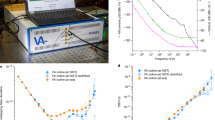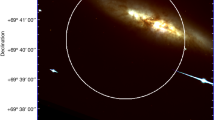Abstract
Of the over 200 known extrasolar planets, 14 exhibit transits in front of their parent stars as seen from Earth. Spectroscopic observations of the transiting planets can probe the physical conditions of their atmospheres1,2. One such technique3,4 can be used to derive the planetary spectrum by subtracting the stellar spectrum measured during eclipse (planet hidden behind star) from the combined-light spectrum measured outside eclipse (star + planet). Although several attempts have been made from Earth-based observatories, no spectrum has yet been measured for any of the established extrasolar planets. Here we report a measurement of the infrared spectrum (7.5–13.2 µm) of the transiting extrasolar planet HD 209458b. Our observations reveal a hot thermal continuum for the planetary spectrum, with an approximately constant ratio to the stellar flux over this wavelength range. Superposed on this continuum is a broad emission peak centred near 9.65 µm that we attribute to emission by silicate clouds. We also find a narrow, unidentified emission feature at 7.78 µm. Models of these ‘hot Jupiter’5 planets predict a flux peak6,7,8,9 near 10 µm, where thermal emission from the deep atmosphere emerges relatively unimpeded by water absorption, but models dominated by water fit the observed spectrum poorly.
This is a preview of subscription content, access via your institution
Access options
Subscribe to this journal
Receive 51 print issues and online access
$199.00 per year
only $3.90 per issue
Buy this article
- Purchase on Springer Link
- Instant access to full article PDF
Prices may be subject to local taxes which are calculated during checkout



Similar content being viewed by others
References
Charbonneau, D., Brown, T. M., Noyes, R. W. & Gilliland, R. L. Detection of an extrasolar planet atmosphere. Astrophys. J. 568, 377–384 (2002)
Deming, D., Brown, T. M., Charbonneau, D., Harrington, J. & Richardson, L. J. A new search for carbon monoxide absorption in the transmission spectrum of the extrasolar planet HD 209458b. Astrophys. J. 622, 1149–1159 (2005)
Richardson, L. J. et al. Infrared observations during the secondary eclipse of HD 209458b. I. 3.6 Micron occultation spectroscopy using the Very Large Telescope. Astrophys. J. 584, 1053–1062 (2003)
Richardson, L. J., Deming, D. & Seager, S. Infrared observations during the secondary eclipse of HD 209458b. II. Strong limits on the infrared spectrum near 2.2 microns. Astrophys. J. 597, 581–589 (2003)
Collier Cameron, A. Extrasolar planets: What are hot Jupiters made of? Astron. Geophys. 43, 21–24 (2002)
Marley, M. S., Fortney, J., Seager, S. & Barman, T. Atmospheres of extrasolar giant planets. Preprint at 〈http://arxiv.org/astro-ph/0602468〉 (2006)
Burrows, A. A theoretical look at the direct detection of giant planets outside the Solar System. Nature 433, 261–268 (2005)
Sudarsky, D., Burrows, A. & Hubeny, I. Theoretical spectra and atmospheres of extrasolar giant planets. Astrophys. J. 588, 1121–1148 (2003)
Seager, S. & Sasselov, D. D. Extrasolar giant planets under strong stellar irradiation. Astrophys. J. 502, L157–L161 (1998)
Houck, J. R. et al. The Infrared Spectrograph (IRS) on the Spitzer Space Telescope. Astrophys. J. 154, (Suppl.)18–24 (2004)
Werner, M. W. et al. The Spitzer Space Telescope Mission. Astrophys. J. 154, (Suppl.)1–9 (2004)
Seager, S. et al. On the dayside thermal emission of hot Jupiters. Astrophys. J. 632, 1122–1131 (2005)
Deming, D., Seager, S., Richardson, L. J. & Harrington, J. Infrared radiation from an extrasolar planet. Nature 434, 740–743 (2005)
Dorschner, J. Infrared spectra of silicate grains. Astron. Nachr. 293, 53–55 (1971)
Kessler-Silacci, J. et al. C2D Spitzer IRS spectra of disks around T Tauri stars. I. Silicate emission and grain growth. Astrophys. J. 639, 275–291 (2006)
Burrows, A. & Sharp, C. M. Chemical equilibrium abundances in brown dwarf and extrasolar giant planet atmospheres. Astrophys. J. 512, 843–863 (1999)
Seager, S., Whitney, B. A. & Sasselov, D. D. Photometric light curves and polarization of close-in extrasolar giant planets. Astrophys. J. 540, 504–520 (2000)
Cushing, M. C. et al. A Spitzer Infrared Spectrograph spectral sequence of M, L, and T dwarfs. Astrophys. J. 648, 614–628 (2006)
Hubeny, I., Burrows, A. & Sudarsky, D. A possible bifurcation in atmospheres of strongly irradiated stars and planets. Astrophys. J. 594, 1011–1018 (2003)
Charbonneau, D. et al. Detection of thermal emission from an extrasolar planet. Astrophys. J. 626, 523–529 (2005)
Fortney, J. J., Marley, M. S., Lodders, K., Saumon, D. & Freedman, R. Comparative planetary atmospheres: Models of TrES-1 and HD 209458b. Astrophys. J. 627, L69–L72 (2005)
Fortney, J. J., Saumon, D., Marley, M. S., Lodders, K. & Freedman, R. S. Atmosphere, interior, and evolution of the metal-rich transiting planet HD 149026b. Astrophys. J. 642, 495–504 (2006)
Vidal-Madjar, A. et al. An extended upper atmosphere around the extrasolar planet HD209458b. Nature 422, 143–146 (2003)
Rothman, L. S. et al. The HITRAN 2004 molecular spectroscopic database. J. Quant. Spectrosc. Radiat. Transf. 96, 139–204 (2005)
Sloan, G. C. et al. Mid-infrared spectra of polycyclic aromatic hydrocarbon emission in Herbig Ae/Be stars. Astrophys. J. 632, 956–963 (2005)
Gardner, J. P. et al. The James Webb Space Telescope. Space Sci. Rev. 123, 485–606 (2006)
Tarter, J. C. et al. A re-appraisal of the habitability of planets around M dwarf stars. Preprint at 〈http://arxiv.org/astro-ph/0609799〉 (2006)
Brown, T. M., Charbonneau, D., Gilliland, R. L., Noyes, R. W. & Burrows, A. Hubble Space Telescope time-series photometry of the transiting planet of HD 209458. Astrophys. J. 552, 699–709 (2001)
Knutson, H., Charbonneau, D., Noyes, R. W., Brown, T. M. & Gilliland, R. L. Using stellar limb-darkening to refine the properties of HD 209458b. Astrophys. J. 655, 564–575 (2007)
Deming, D., Harrington, J., Seager, S. & Richardson, L. J. Strong infrared emission from the extrasolar planet HD 189733b. Astrophys. J. 644, 560–564 (2006)
Acknowledgements
This work is based on observations made with the Spitzer Space Telescope, which is operated by the Jet Propulsion Laboratory, California Institute of Technology, under a contract with NASA. We acknowledge cooperation with D. Charbonneau, C. Grillmair and H. Knutson. Our understanding of the long-term telescope pointing drift was derived from H. Knutson’s study of the effect in their 30 h programme to measure the light curve of HD 189733b. D. Charbonneau provided his measurement of the eclipse depth of HD 209485b, which was key to casting our results in terms of contrast, rather than differential contrast. We also thank M. Swain and A. Mainzer for discussions regarding the telescope pointing oscillation. We thank the teams that designed, built, operate and support the Spitzer Space Telescope and the IRS. We also thank the NASA Astrobiology Institute, which has centres at both NASA Goddard and the Carnegie Institution of Washington. L.J.R. acknowledges support as a NASA Postdoctoral Fellow at NASA Goddard (formerly the NRC Research Associateship Program). K.H. performed the high-pass filtering analysis as part of her participation in the Summer Undergraduate Internship in Astrobiology, funded by the Goddard Center for Astrobiology. S.S. thanks the Spitzer Theory Program and the Carnegie Institution of Washington for support.
Author information
Authors and Affiliations
Corresponding author
Ethics declarations
Competing interests
Reprints and permissions information is available at www.nature.com/reprints. The authors declare no competing financial interests.
Supplementary information
Supplementary Methods
This file contains Supplementary Methods with detailed description of methods used to reduce the data, including Supplementary Figures 1-4 and additional references. (PDF 417 kb)
Supplementary Data
This file contains Supplementary Data with the actual spectra derived from our data for both eclipse events. Columns are wavelength in microns, contrast, and 1-σ uncertainty (TXT 7 kb)
Rights and permissions
About this article
Cite this article
Richardson, L., Deming, D., Horning, K. et al. A spectrum of an extrasolar planet. Nature 445, 892–895 (2007). https://doi.org/10.1038/nature05636
Received:
Accepted:
Issue Date:
DOI: https://doi.org/10.1038/nature05636
This article is cited by
-
SO2, silicate clouds, but no CH4 detected in a warm Neptune
Nature (2024)
-
Effect of clouds on emission spectra for super Venus
Astrophysics and Space Science (2022)
-
Highlights of exoplanetary science from Spitzer
Nature Astronomy (2020)
-
Transit spectroscopy of exoplanets from space: how to optimize the wavelength coverage and spectral resolving power
Experimental Astronomy (2015)
Comments
By submitting a comment you agree to abide by our Terms and Community Guidelines. If you find something abusive or that does not comply with our terms or guidelines please flag it as inappropriate.



